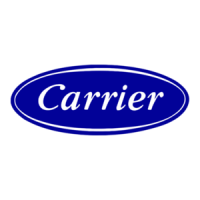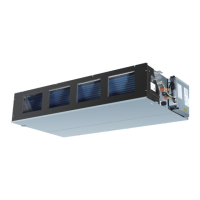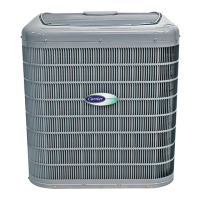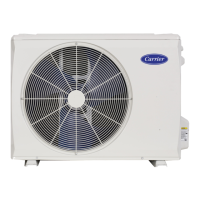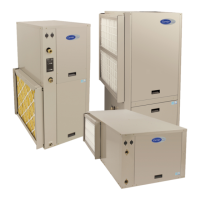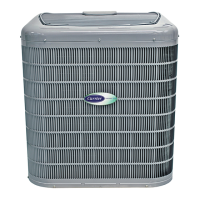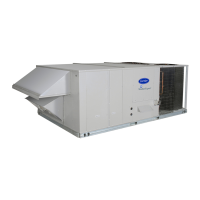4
The temperature control selector is a dial, lever, or set of but-
tons that allows you to establish the temperature that you wish
to maintain for your personal comfort. Some thermostats have
2 temperature control selectors: 1 for setting the temperature
desired during cooling operation, and 1 for setting the temper-
ature desired during heating operation. A typical setting for
year-round comfort is 72
°
F.
The FAN control offers 2 options for controlling the blower: AUTO
and ON. When set to AUTO, the blower runs only when the heat
pump is operating. When the FAN switch is set at the ON position,
the blower runs continuously.
Typically, the SYSTEM or MODE control on your thermostat
offers the following selections: COOL, OFF, HEAT, AUTO,
and EMERGENCY HEAT. Some thermostats may have a sep-
arate switch for EMERGENCY HEAT. The heat pump will not
operate when the SYSTEM OR MODE control is set to OFF.
With the SYSTEM or MODE control set to COOL, your heat
pump will provide cooling when the indoor temperature rises
above the level you wish to maintain. With the SYSTEM or
MODE control set to HEAT, your heat pump will provide
warmth whenever the indoor temperature falls below the level
that you have selected.
The AUTO selection found on some thermostats provides for
automatic changeover between cooling and heating. With the
SYSTEM or MODE control set to AUTO, cooling operation is
activated when the indoor temperature rises above the thermo-
stat cooling temperature setting, or heating operation is acti-
vated when the indoor temperature drops below the thermostat
heating setting.
Depending on your typical winter heating needs, your home
comfort system may include a supplementary heating source.
The EMERGENCY HEAT setting (EHEAT) provides for con-
venient selection between the 2 heating appliances. Your heat
pump will operate when the SYSTEM or MODE control is set
to HEAT. With the SYSTEM or MODE control set to EHEAT,
the heat pump will turn off and the supplementary heat source
will be activated.
In certain geographic areas and in certain applications, supple-
mental heat is not required. Any questions regarding your
application should be directed to your dealer.
Your thermostat may be PROGRAMMABLE or NON-PRO-
GRAMMABLE. A NON-PROGRAMMABLE thermostat
does not allow the temperature settings to be varied throughout
the day or week without physically changing the settings. A
PROGRAMMABLE thermostat allows various daily temper-
ature changes to be preset. During the winter, for example, you
may wish to “set back” the temperature of your home at night,
then have the temperature return to normal prior to waking up.
The home’s temperature can then be lowered again during the
day when no one is at home, but again be at peak comfort level
when your family returns home. During the summer, the oppo-
site changes might be programmed. When properly used, the
programming can result in energy savings on your home’s
heating and cooling.
COOLING MODE
When operating in cooling mode, your heat pump will run in
cooling mode until the indoor temperature is lowered to the
level you have selected. On extremely hot days, your heat
pump will run for longer periods at a time and have shorter
“off” periods than on moderate days.
The following are typical conditions that add extra heat and/or
humidity to your home. Your heat pump will work longer to
keep your home comfortable under these conditions:
• Entrance doors are frequently opened and closed
• Laundry appliances are being operated
• A shower is running
• More than the usual number of people are present in the
home
• More than the normal number of electric lights are in use
• Drapes are open on the sunny side of the home
HEATING MODE
With the SYSTEM or MODE control of your indoor thermo-
stat set to HEAT, your heat pump will run in heating mode until
room temperature is raised to the level you have selected. Of
course, your heat pump will have to operate for longer periods
to maintain a comfortable environment on cooler days and
nights than on moderate ones.
SUPPLEMENTAL HEAT
Your heat pump is your primary heating source. Your system
may also be equipped with a supplemental heating source such
as electric, gas, or oil. On cold days and nights, your system
will automatically turn on the supplemental heat in order to
maintain the level of comfort your have selected.
Your Carrier electronic thermostat will display the words
“ENERGY SAVINGS” when the heat pump is providing all
the heat that is necessary. When additional heat is required,
your thermostat will turn on the supplemental heat (if
equipped) and will display the “AUX HT” message.
DEFROST MODE
When your heat pump is providing heat to your home and the
outdoor temperature drops below 45
°
F, moisture may begin to
freeze on the surface of the outdoor coil. If allowed to build up,
this ice would impede airflow across the coil and reduce the
amount of heat absorbed from the outside air. So, to maintain
energy-efficient operation, your heat pump has an automatic
defrost mode.
The defrost mode starts at a preset time interval of 90 minutes,
although, it may be reset to either 30 or 50 minutes. Defrost
will start at the preset time only if the ice is sufficient to inter-
fere with normal heating operation.
After the ice is melted from the outdoor coil, or after a maxi-
mum of 10 minutes in defrost mode, the unit automatically
switches back to normal heating operation.
Do not be alarmed if steam or fog appears at the outdoor unit
during defrost mode. Water vapor from the melting ice may
condense into a mist in the cold outside air.
During certain weather conditions such as heavy snow and
freezing rain it is not uncommon for ice to build up on the
outdoor unit grille. This is normal for these weather conditions.
Do not attempt to remove the ice from the outdoor unit grille.
This condition will not affect the proper function of the unit
and will clear within a few days.
EMERGENCY HEAT MODE
The emergency heat (EHEAT) setting on your Carrier electron-
ic thermostat can be used to turn off your heat pump and use
only the supplemental heating source (if equipped). The Aux-
iliary Heat Indicator (AUX HT) will be displayed while your
system is operating in EHEAT mode.
Emergency heat is not normally used. There may be situations,
however, where it is necessary. Your Carrier programmable
electronic thermostat has a service alarm indicator. In the heat-
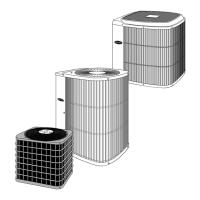
